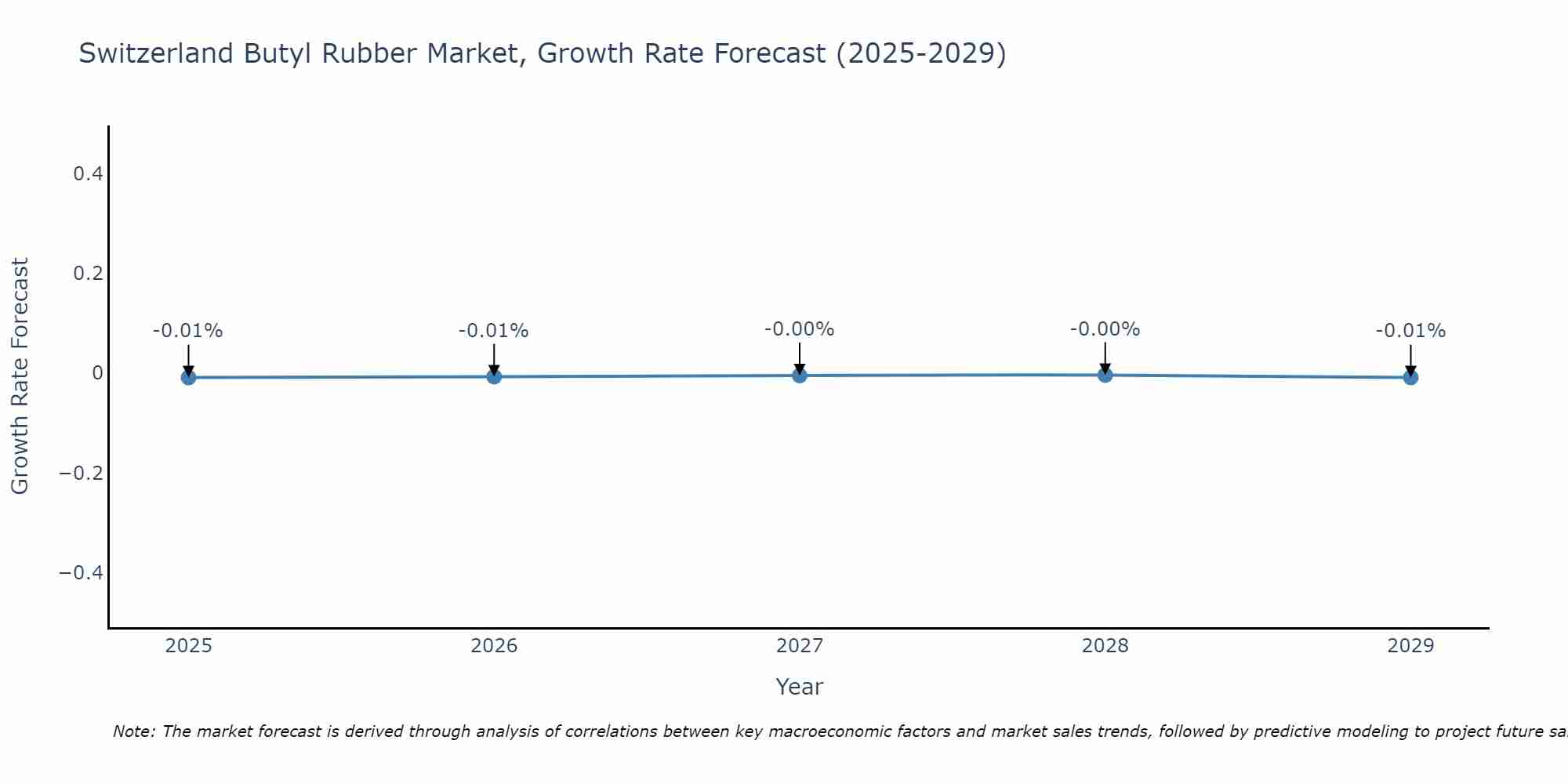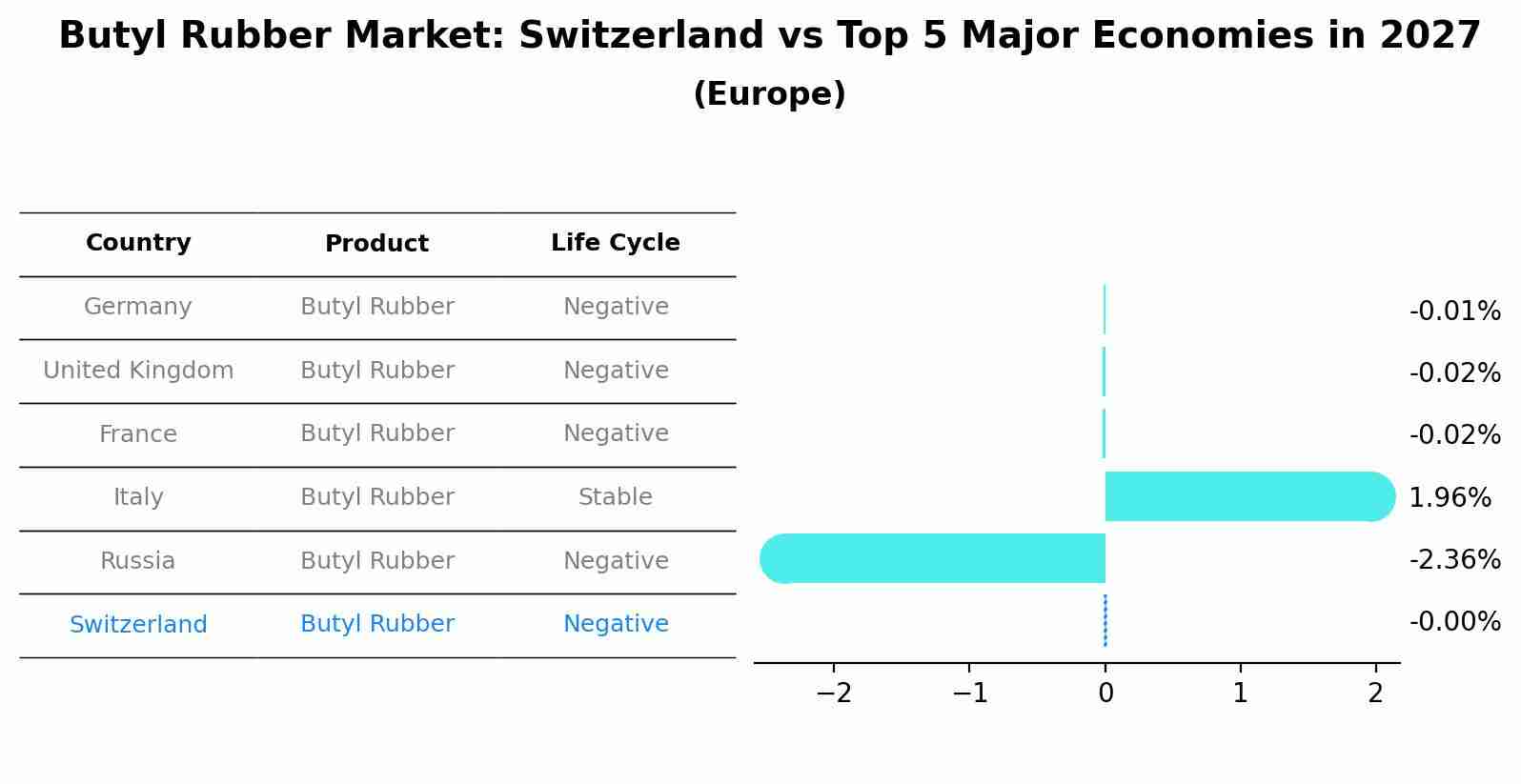Switzerland Butyl Rubber Market (2025-2031) | Outlook, Growth, Trends, Analysis, Value, Forecast, Industry, Revenue, Share, Segmentation, Size & Companies
| Product Code: ETC5252013 | Publication Date: Nov 2023 | Updated Date: Aug 2025 | Product Type: Market Research Report | |
| Publisher: 6Wresearch | Author: Bhawna Singh | No. of Pages: 60 | No. of Figures: 30 | No. of Tables: 5 |
Switzerland Butyl Rubber Market Size Growth Rate
The Switzerland Butyl Rubber Market is projected to witness mixed growth rate patterns during 2025 to 2029. Growth accelerates to -0.00% in 2028, following an initial rate of -0.01%, before easing to -0.01% at the end of the period.

Butyl Rubber Market: Switzerland vs Top 5 Major Economies in 2027 (Europe)
By 2027, the Butyl Rubber market in Switzerland is anticipated to reach a growth rate of -0.00%, as part of an increasingly competitive Europe region, where Germany remains at the forefront, supported by United Kingdom, France, Italy and Russia, driving innovations and market adoption across sectors.

Switzerland Butyl Rubber Market Overview
The butyl rubber market in Switzerland is experiencing steady growth, driven by its applications in the automotive and medical sectors. The material`s excellent air retention properties make it ideal for tire manufacturing, while its resistance to chemicals and UV light expands its use in various industrial applications. Swiss manufacturers are focusing on sustainable production methods and recycling initiatives to minimize environmental impact, aligning with the country`s stringent regulations on chemical production and waste management.
Drivers of the market
The demand for butyl rubber in Switzerland is primarily driven by its widespread application in the automotive and tire industries. Butyl rubber`s excellent air retention properties make it an ideal material for inner tubes and tires, which are crucial for vehicle performance. The ongoing advancements in the automotive sector, coupled with the increase in vehicle production and sales, are expected to sustain demand. Furthermore, the rising emphasis on energy efficiency and environmental sustainability in manufacturing processes is propelling the use of butyl rubber in sealants and adhesives, broadening its application scope.
Challenges of the market
The butyl rubber market in Switzerland encounters challenges tied to environmental concerns and stringent regulations on synthetic rubber production. The manufacturing process of butyl rubber involves petrochemicals, raising concerns over carbon emissions and sustainability. Additionally, rising raw material costs and the dependence on international suppliers make the market vulnerable to global supply chain disruptions. Competition from other synthetic rubbers, which offer similar or enhanced properties, adds further strain on the market.
Government Policy of the market
The butyl rubber market in Switzerland is shaped by environmental policies and industrial regulations that govern the chemical industry. The Swiss government implements strict environmental protection laws, particularly focusing on reducing industrial emissions and waste management in rubber manufacturing. Companies are required to comply with guidelines established by the Swiss Federal Office for the Environment (FOEN), which emphasize the safe handling and disposal of chemical substances. Switzerlands involvement in international treaties, such as the REACH regulation of the EU, also affects the import and export of butyl rubber, ensuring that chemical products meet safety and environmental standards.
Key Highlights of the Report:
- Switzerland Butyl Rubber Market Outlook
- Market Size of Switzerland Butyl Rubber Market, 2024
- Forecast of Switzerland Butyl Rubber Market, 2031
- Historical Data and Forecast of Switzerland Butyl Rubber Revenues & Volume for the Period 2021-2031
- Switzerland Butyl Rubber Market Trend Evolution
- Switzerland Butyl Rubber Market Drivers and Challenges
- Switzerland Butyl Rubber Price Trends
- Switzerland Butyl Rubber Porter`s Five Forces
- Switzerland Butyl Rubber Industry Life Cycle
- Historical Data and Forecast of Switzerland Butyl Rubber Market Revenues & Volume By Product Type for the Period 2021-2031
- Historical Data and Forecast of Switzerland Butyl Rubber Market Revenues & Volume By Regular Butyl Rubber for the Period 2021-2031
- Historical Data and Forecast of Switzerland Butyl Rubber Market Revenues & Volume By Halo Butyl Rubber for the Period 2021-2031
- Historical Data and Forecast of Switzerland Butyl Rubber Market Revenues & Volume By Bromo-Butyl Rubber for the Period 2021-2031
- Historical Data and Forecast of Switzerland Butyl Rubber Market Revenues & Volume By Chloro-Butyl Rubber for the Period 2021-2031
- Historical Data and Forecast of Switzerland Butyl Rubber Market Revenues & Volume By Application for the Period 2021-2031
- Historical Data and Forecast of Switzerland Butyl Rubber Market Revenues & Volume By Tires & Tubes for the Period 2021-2031
- Historical Data and Forecast of Switzerland Butyl Rubber Market Revenues & Volume By Pharmaceuticals for the Period 2021-2031
- Historical Data and Forecast of Switzerland Butyl Rubber Market Revenues & Volume By Adhesives & Sealants for the Period 2021-2031
- Historical Data and Forecast of Switzerland Butyl Rubber Market Revenues & Volume By Automotive for the Period 2021-2031
- Historical Data and Forecast of Switzerland Butyl Rubber Market Revenues & Volume By Others for the Period 2021-2031
- Switzerland Butyl Rubber Import Export Trade Statistics
- Market Opportunity Assessment By Product Type
- Market Opportunity Assessment By Application
- Switzerland Butyl Rubber Top Companies Market Share
- Switzerland Butyl Rubber Competitive Benchmarking By Technical and Operational Parameters
- Switzerland Butyl Rubber Company Profiles
- Switzerland Butyl Rubber Key Strategic Recommendations
Frequently Asked Questions About the Market Study (FAQs):
1 Executive Summary |
2 Introduction |
2.1 Key Highlights of the Report |
2.2 Report Description |
2.3 Market Scope & Segmentation |
2.4 Research Methodology |
2.5 Assumptions |
3 Switzerland Butyl Rubber Market Overview |
3.1 Switzerland Country Macro Economic Indicators |
3.2 Switzerland Butyl Rubber Market Revenues & Volume, 2021 & 2031F |
3.3 Switzerland Butyl Rubber Market - Industry Life Cycle |
3.4 Switzerland Butyl Rubber Market - Porter's Five Forces |
3.5 Switzerland Butyl Rubber Market Revenues & Volume Share, By Product Type, 2021 & 2031F |
3.6 Switzerland Butyl Rubber Market Revenues & Volume Share, By Application, 2021 & 2031F |
4 Switzerland Butyl Rubber Market Dynamics |
4.1 Impact Analysis |
4.2 Market Drivers |
4.2.1 Increasing demand for butyl rubber in automotive and construction industries |
4.2.2 Growing emphasis on sustainability and eco-friendly materials |
4.2.3 Technological advancements leading to improved product performance |
4.3 Market Restraints |
4.3.1 Fluctuating raw material prices impacting production costs |
4.3.2 Competition from substitute materials like natural rubber and synthetic rubber |
4.3.3 Regulatory hurdles related to environmental concerns and waste management |
5 Switzerland Butyl Rubber Market Trends |
6 Switzerland Butyl Rubber Market Segmentations |
6.1 Switzerland Butyl Rubber Market, By Product Type |
6.1.1 Overview and Analysis |
6.1.2 Switzerland Butyl Rubber Market Revenues & Volume, By Regular Butyl Rubber, 2021-2031F |
6.1.3 Switzerland Butyl Rubber Market Revenues & Volume, By Halo Butyl Rubber, 2021-2031F |
6.1.4 Switzerland Butyl Rubber Market Revenues & Volume, By Bromo-Butyl Rubber, 2021-2031F |
6.1.5 Switzerland Butyl Rubber Market Revenues & Volume, By Chloro-Butyl Rubber, 2021-2031F |
6.2 Switzerland Butyl Rubber Market, By Application |
6.2.1 Overview and Analysis |
6.2.2 Switzerland Butyl Rubber Market Revenues & Volume, By Tires & Tubes, 2021-2031F |
6.2.3 Switzerland Butyl Rubber Market Revenues & Volume, By Pharmaceuticals, 2021-2031F |
6.2.4 Switzerland Butyl Rubber Market Revenues & Volume, By Adhesives & Sealants, 2021-2031F |
6.2.5 Switzerland Butyl Rubber Market Revenues & Volume, By Automotive, 2021-2031F |
6.2.6 Switzerland Butyl Rubber Market Revenues & Volume, By Others, 2021-2031F |
7 Switzerland Butyl Rubber Market Import-Export Trade Statistics |
7.1 Switzerland Butyl Rubber Market Export to Major Countries |
7.2 Switzerland Butyl Rubber Market Imports from Major Countries |
8 Switzerland Butyl Rubber Market Key Performance Indicators |
8.1 Research and development investment in butyl rubber technology |
8.2 Adoption rate of butyl rubber in new applications and industries |
8.3 Environmental impact assessment and sustainability certifications for butyl rubber production |
8.4 Market acceptance and awareness of butyl rubber as a superior material option |
9 Switzerland Butyl Rubber Market - Opportunity Assessment |
9.1 Switzerland Butyl Rubber Market Opportunity Assessment, By Product Type, 2021 & 2031F |
9.2 Switzerland Butyl Rubber Market Opportunity Assessment, By Application, 2021 & 2031F |
10 Switzerland Butyl Rubber Market - Competitive Landscape |
10.1 Switzerland Butyl Rubber Market Revenue Share, By Companies, 2024 |
10.2 Switzerland Butyl Rubber Market Competitive Benchmarking, By Operating and Technical Parameters |
11 Company Profiles |
12 Recommendations | 13 Disclaimer |
- Single User License$ 1,995
- Department License$ 2,400
- Site License$ 3,120
- Global License$ 3,795
Search
Related Reports
- ASEAN Bearings Market (2025-2031) | Strategy, Consumer Insights, Analysis, Investment Trends, Opportunities, Growth, Size, Share, Industry, Revenue, Segments, Value, Segmentation, Supply, Forecast, Restraints, Outlook, Competition, Drivers, Trends, Demand, Pricing Analysis, Competitive, Strategic Insights, Companies, Challenges
- Europe Flooring Market (2025-2031) | Outlook, Share, Industry, Trends, Forecast, Companies, Revenue, Size, Analysis, Growth & Value
- Saudi Arabia Manlift Market (2025-2031) | Outlook, Size, Growth, Trends, Companies, Industry, Revenue, Value, Share, Forecast & Analysis
- Uganda Excavator, Crane, and Wheel Loaders Market (2025-2031) | Strategy, Consumer Insights, Analysis, Investment Trends, Opportunities, Growth, Size, Share, Industry, Revenue, Segments, Value, Segmentation, Supply, Forecast, Restraints, Outlook, Competition, Drivers, Trends, Demand, Pricing Analysis, Competitive, Strategic Insights, Companies, Challenges
- Rwanda Excavator, Crane, and Wheel Loaders Market (2025-2031) | Strategy, Consumer Insights, Analysis, Investment Trends, Opportunities, Growth, Size, Share, Industry, Revenue, Segments, Value, Segmentation, Supply, Forecast, Restraints, Outlook, Competition, Drivers, Trends, Demand, Pricing Analysis, Competitive, Strategic Insights, Companies, Challenges
- Kenya Excavator, Crane, and Wheel Loaders Market (2025-2031) | Strategy, Consumer Insights, Analysis, Investment Trends, Opportunities, Growth, Size, Share, Industry, Revenue, Segments, Value, Segmentation, Supply, Forecast, Restraints, Outlook, Competition, Drivers, Trends, Demand, Pricing Analysis, Competitive, Strategic Insights, Companies, Challenges
- Angola Excavator, Crane, and Wheel Loaders Market (2025-2031) | Strategy, Consumer Insights, Analysis, Investment Trends, Opportunities, Growth, Size, Share, Industry, Revenue, Segments, Value, Segmentation, Supply, Forecast, Restraints, Outlook, Competition, Drivers, Trends, Demand, Pricing Analysis, Competitive, Strategic Insights, Companies, Challenges
- Israel Intelligent Transport System Market (2025-2031) | Strategy, Consumer Insights, Analysis, Investment Trends, Opportunities, Growth, Size, Share, Industry, Revenue, Segments, Value, Segmentation, Supply, Forecast, Restraints, Outlook, Competition, Drivers, Trends, Demand, Pricing Analysis, Competitive, Strategic Insights, Companies, Challenges
- Uganda Precast and Aggregate Market (2025-2031) | Strategy, Consumer Insights, Analysis, Investment Trends, Opportunities, Growth, Size, Share, Industry, Revenue, Segments, Value, Segmentation, Supply, Forecast, Restraints, Outlook, Competition, Drivers, Trends, Demand, Pricing Analysis, Competitive, Strategic Insights, Companies, Challenges
- Australia IT Asset Disposal Market (2025-2031) | Strategy, Consumer Insights, Analysis, Investment Trends, Opportunities, Growth, Size, Share, Industry, Revenue, Segments, Value, Segmentation, Supply, Forecast, Restraints, Outlook, Competition, Drivers, Trends, Demand, Pricing Analysis, Competitive, Strategic Insights, Companies, Challenges
Industry Events and Analyst Meet
Our Clients
Whitepaper
- Middle East & Africa Commercial Security Market Click here to view more.
- Middle East & Africa Fire Safety Systems & Equipment Market Click here to view more.
- GCC Drone Market Click here to view more.
- Middle East Lighting Fixture Market Click here to view more.
- GCC Physical & Perimeter Security Market Click here to view more.
6WResearch In News
- Doha a strategic location for EV manufacturing hub: IPA Qatar
- Demand for luxury TVs surging in the GCC, says Samsung
- Empowering Growth: The Thriving Journey of Bangladesh’s Cable Industry
- Demand for luxury TVs surging in the GCC, says Samsung
- Video call with a traditional healer? Once unthinkable, it’s now common in South Africa
- Intelligent Buildings To Smooth GCC’s Path To Net Zero













